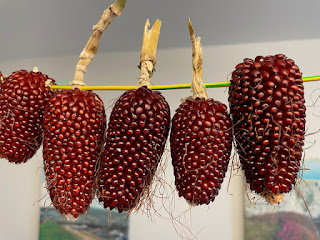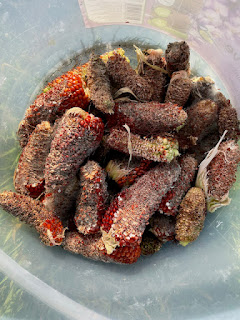Popcorn
This month we are taking a break from our core topic of toxic plants and looking at the cradle-to-grave life cycle of a plant which is very much non-toxic and edible, namely popcorn, better known as flint corn. I grew this as a fun plant to try to get my teenage son interested in food production (he loves popcorn). Not much success getting my son interested so far, but our manic dog Maple shows great enthusiasm for gardening. When I dig, she digs (although not always in the right place). When I pull things up, she pulls things up. When I get my gardening tools out, she thinks they are for her and runs off with them. I just need to focus her enthusiasm a bit better. 
Strawberry Popcorn drying 
Maple helping with the gardening
But seriously, knowing how to produce food will become increasingly important in the years to come, because it’s my belief - which I realise is still only shared by a minority of people, and no politicians - that humanity is in overshoot, and the 8 billion of us living on the world today are an unsustainable number. Most people are fed by fossil fuel dependent agriculture, and when the fossil fuels go away, the fertilisers, pesticides, tractors, refrigerated ships and trucks and the rest of the food producing infrastructure will go away, the amount of available food will greatly reduce, and eventually the population will reduce, because that’s the way it’s always been for millions of years.
Our present era of abundant food for most people is a historical anomaly, it is coming to an end, and I think we are heading for a significant correction in population in the latter part of this century. I probably won’t live to see it but my children probably will. Knowing how to produce food by hand will become a valuable skill, so I’m starting to educate myself (and hopefully my family) now.
If you’ve been following this blog you may remember that last spring I conducted a small experiment to compare the germination rates of old and new popcorn seeds. The results are now in:
2021 seeds: germination rate 60%
2022 seeds: germination rate 93%
So there you have it. It’s best to use fresh seed. If you have some old seed, it’s still worth planting, but you may need to plant more seed to get the same number of plants.
This year I planted an heirloom variety called “Strawberry Popcorn” which produces bright red cobs. It’s about the fifth year I have tried to grow popcorn, but my previous attempts have all failed because the crop got choked by weeds, or died from drought, or got eaten by long-tails (longies) before I could get to it. I was determined that this time, it was going to be different.
 |
| Owl on a stick. Might as well have been a lollipop on a stick for all the good it did. |
 |
| Plastic pop bottles. Totally useless. |
So this year, I was ready for them with a new weapon: wire mesh condoms. Yessir. I decided that I would wait until I saw the first sign of damage to the crop, then enclose each individual cob in its own personal wire mesh sheath. You can see them here:
 |
| The only condom with a 100% success rate |
Finally, this worked, although I underestimated the speed at which the longies would attack the crop. As fast as I was putting the condoms on, they were eating the unprotected cobs. I lost about a third of the crop that way, but two-thirds survived to the next stage, which was harvesting and drying the cobs.
 |
| A bucketful of cobs spoiled by the longies before I could protect them |
In order for popcorn to “pop”, the moisture content has to be just right - ideally between 13-14.5%. Too much or too little water and the kernels won’t pop. So you need to let the cobs dry on the plant until they are brown, and then harvest them and dry them some more indoors for another couple of weeks. The best way to dry them indoors is to hang them in a warm place. I used electric cables passed through holes drilled in each cob, hung them in my medical office and told the patients they were Halloween decorations.
 |
| The cobs are now brown and dry and ready to be harvested |
Once they are dry, you need to strip the kernels off the cobs. They come off a lot more easily when they are dry than when they are wet, but if you are stripping a few dozen cobs, you still get blisters on your thumbs if you are not careful - best to wear gloves.
Then when you have a big bowl of kernels, take them outside on a windy day and pour the kernels from one bowl to another a few times. The chaff (bits of husk and silk) blows away and you are left with just the kernels. You need to do this because if the chaff gets into the cooking process it can give the popcorn a burnt flavour.
Then bottle it:
Then cook it! You can buy microwaveable popcorn at the grocery store, but I found this method of cooking didn’t work very well for my home-grown popcorn. It responded best to being cooked in the traditional way in a shallow pan with a lid together with a little olive oil and salt. Heat the oil for a couple of minutes, then pour in the kernels. After another two minutes they should begin to pop, and after six minutes they should be done.
It’s best to leave the lid slightly off the pan, on enough to stop the kernels from jumping all over the kitchen, but off enough to let the steam escape. If the popped corn re-absorbs the steam released in the cooking it may go soggy and chewy. Strangely enough, although the kernels are red on the outside, they are white on the inside.
 |
| Freshly popped corn in the pan |
And finally, I entered my popcorn in the Kirk Andreas Produce Show and won first prize! Sort of. Unfortunately, not being familiar with the show rules, I entered it in the wrong category, namely “Root vegetables (any other variety)” and it is not a root vegetable. There was nothing else in that category so the organisers had to either give me a prize or disqualify me. Fortunately, they chose the former. I’ll know better next year.
 |
| So I cheated. It is what it is. |
For my next post in spring, I hope to return to our core theme of Toxic Plants by looking at one of the so-called “witches herbs”, Henbane. Until then, have a merry Yule.
Slaynt vie, bea veayn, beeal fliugh as baase ayns Mannin






2.jpg)
Comments
Post a Comment